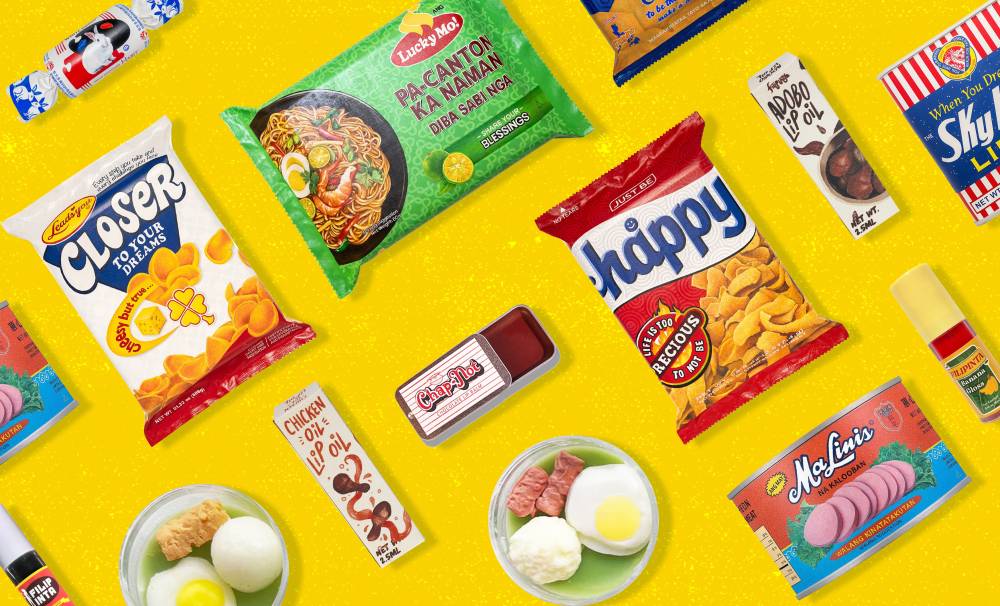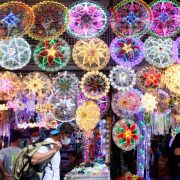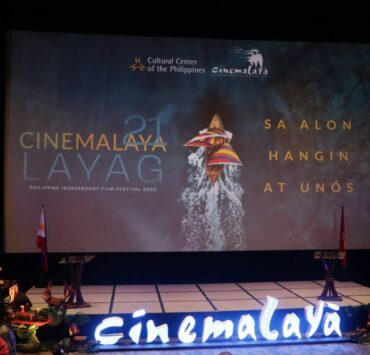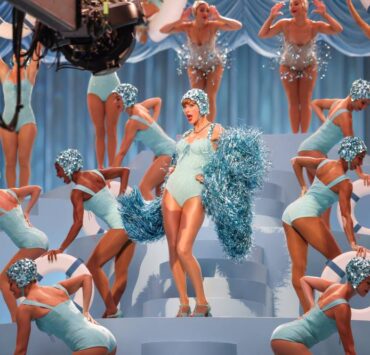Made you look

What do banana ketchup, snack wrappers, and mythical monsters have in common? In the hands of two Filipino creatives, they become love letters to memory. There’s a thrill in seeing something familiar reimagined, not for novelty’s sake, but as a way to hold on to what makes us who we are. A lipstick that looks like your favorite merienda. A painting that feels like a time machine to your sari-sari store childhood. These objects do more than catch your eye. They root you. They remind you that your memories matter, and that joy can come from the most unexpected places.
That’s the kind of energy I’ve felt from two artists whose work I’ve been quietly admiring for months: beauty creator Rissa Coronado of Filipinta Beauty and visual artist Carlo Tanseco. One works in lipstick and shimmer, the other in paint and playful text. Both create art that feeds the Filipino soul.
Filipinta’s world of playful beauty
Filipinta Beauty doesn’t just sell makeup. It offers a playful kind of pride, a chance to hold heritage in your hand and swipe it across your lips. The brand is known for turning beloved Filipino staples like banana ketchup, adobo, lumpia, and taho into glosses, palettes, and pigments. It’s whimsical, yes, but also deliberate. A beauty brand shaped by deep research, humor, and heart.
At the center of it all is Rissa Coronado, the one-woman team behind Filipinta. She launched the brand in 2019 and has since been building a colorful world of products she describes as “consumable art pieces you can either display or use.”
“I always start with the story,” Coronado explains. “I want to highlight a specific tradition or food we have and build around that idea.” Though she’s based in the US, her creative process is rooted in the Philippines. “I was extremely homesick. I tapped into my childhood and younger self to create products that stay true to who I am.”
Filipinta’s fans love the originality, but it’s the cultural specificity that hits home. Each product is a nod to something unmistakably Filipino, from the name to the scent to the shade. Her Banana Ketchup Lip Gloss quickly became a standout. “It’s the product that everyone gravitated toward because it’s distinctly Filipino,” she says.
What most people don’t know? Coronado does it all alone, juggling motherhood while designing, packing, and running the brand. “Some people think I have a team. I wish. But it’s really just me, and sometimes the kids help out.”
Now, she’s expanding her creative universe. She’s working on a picture book called “Kabilugan ng Buwan,” which will feature mythical creatures from Filipino folklore. “Our culture is rich with stories and traditions. I will never run out of things to highlight through the brand, and I’m excited about that,” she shares proudly.
Carlo Tanseco’s visual time machines
While some artists preserve culture through archives or documentation, Carlo Tanseco does it with acrylic and wood. His paintings zoom in on everyday Filipino objects, from snack wrappers to sari-sari price tags and turn them into striking works of art. They are bold, graphic, and orderly, but also funny and familiar.
Tanseco’s visual language is unmistakable. His use of grids, symmetry, and pattern is a clear nod to his background in architecture. “My training is reflected in the precision of the patterns and orderly grids,” he explains. “Then I like to break the order with whimsical subjects and catchy texts. They apparently work very well together and have become my artistic DNA.”
His Sari Sari Sabi Sabi series has become iconic in Filipino contemporary art circles, especially for its nostalgic subjects. “The snacks I paint represent moments of happiness when I would be rewarded with treats for having good grades or lazy summertime meriendas.”
But the goal isn’t just to look back. Tanseco uses scale and contrast to invite reflection. “I like to lay the predicate of order and pattern to heighten the contrast of chaos in the foreground.” This is why his work balances graphic design with emotional storytelling.
Tanseco also sees his art as a form of preservation. “Many of these works revisit icons that are slowly fading from memory. I would like to think of it as a way to preserve that part of our culture and, for myself, preserve memories of that era of my youth.”
His exhibit, “The Anthropometric Man,” running from Oct. 4 to Nov. 1, at Art Cube in Makati, continues this exploration of memory and structure. This time, he moves beyond the playful nostalgia of snacks and into something more sculptural and introspective. The figures, built with the same precision that defines his paintings, seem to hold both motion and stillness at once. They invite you to reflect on form, on identity, and on how the human body itself becomes a vessel of memory.
Where nostalgia meets boldness
I haven’t tried Filipinta’s products yet. But the way they light up my feed with whimsy and pride keeps me cheering for Coronado. There’s a sense of delight in seeing something so playful stay so grounded in identity. She could have leaned into anything else, now being surrounded by an entirely different culture, but she chose to create with such bold Filipino spirit. I love that it doesn’t take itself too seriously. And yet it is serious about joy.
Tanseco’s paintings move me in a different way, but for similar reasons. His work gives physical space to the things we often overlook. In making them larger than life, he reminds us how important they really are. We have one of his pieces at home, and I’ve seen his work displayed in the homes of my aunts and family friends. Each time, I find myself smiling. There’s something about the way he elevates the ordinary that fills a space with energy. I always love seeing it.
What makes these two creators stand out is how they use playfulness as a powerful tool. Their work doesn’t beg to be taken seriously, and yet it earns that respect through its imagination and cultural clarity. It’s rooted but never rigid. They capture the spirit of Filipino life in a way that feels fresh without letting go of what makes it familiar. Somehow, they manage to turn personal memories into something that feels collective, something that belongs to all of us.
Coronado and Tanseco are both artists. One makes you feel more beautiful. The other makes your space more beautiful. Through makeup and paint, they turn everyday memories into something worth celebrating.

















